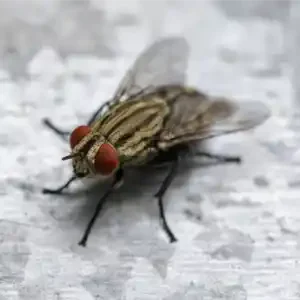![Cluster Flies Invade Illinois Homes [2022 Update] Cluster Flies Invade Illinois Homes [2022 Update]](https://andersonpestsolutions.com/wp-content/uploads/bfi_thumb/dummy-transparent-qlxwr0216icyyxp8ozqo783hseq12o61fzh5f5c5nk.png)
Picture this: It’s the dead of winter in Illinois. Just when you think you’re safe from the mob of insects that disappeared after the first frost, you spot a fly on your windowpane. You move to swat it, but then another appears. And another. And then you begin to hear a low hum coming from your attic. As you head up the stairs, the hum gets louder. And louder. You throw open the attic door, and what you see sends a chill down your spine. Hundreds of black flies cover the walls and floor in a writhing, black mass. The hum is now a deafening buzz as they vibrate their bodies together. Your home is infested with cluster flies.
Sounds like a scene straight from a low-budget horror movie, right? Unfortunately, cluster flies are a common problem for homeowners in both Illinois and Indiana. Fortunately, Anderson Pest Solutions is here to soothe your fears of a cloud of cluster flies with pest control tips straight from our trained experts.
What Are Cluster Flies?
 Cluster flies get their name from their propensity to “cluster” together for warmth, sometimes in massive enough numbers to completely cover windows and doors in a black, vibrating mass. While they pose no specific harm to humans in that they don’t bite, sting, or lay eggs indoors, they’re not exactly welcome guests, and lawsuits have even been filed because so many have found their way into apartments, office buildings, and other large spaces. People often confuse them for houseflies, but if you look closely you’ll notice a few differences:
Cluster flies get their name from their propensity to “cluster” together for warmth, sometimes in massive enough numbers to completely cover windows and doors in a black, vibrating mass. While they pose no specific harm to humans in that they don’t bite, sting, or lay eggs indoors, they’re not exactly welcome guests, and lawsuits have even been filed because so many have found their way into apartments, office buildings, and other large spaces. People often confuse them for houseflies, but if you look closely you’ll notice a few differences:
- Adult cluster flies can measure up to seven millimeters, slightly larger than normal houseflies
- They have distinctive stripes behind their head and yellowish hairs on their thorax
- Unlike other flies, their wings overlap almost completely when folded
- Instead of buzzing around food and waste, they’re more commonly found on south- and west-facing walls and windows
- These flies are strictly parasitic to earthworms; female cluster flies lay their eggs near earthworm burrows, and when the larvae hatch, they infest and feed on the worms. Adult flies prefer to feed on flowers.
How Did Cluster Flies Get In My House?
If they’re not trying to bite us and they’re not after our food, you might be wondering why cluster flies enter your house at all, especially in such massive numbers. When you think about it, though, they’re just doing what any of us would do when the weather turns frosty: seeking out warmth. Cluster flies in Illinois spend the majority of the year outdoors, usually in areas with good farmland where they can find plenty of earthworms for their young to feed on. You can find them almost everywhere in the United States and Canada, except for warmer southern states bordering the Gulf of Mexico.
Because these flies live in mostly cooler climes, they must find some way to survive during the harsh winter months when most other pests simply perish. This is how they developed the knack of infiltrating houses in the fall as a place to hibernate and wait out the cold. They prefer buildings located on open hilltops, and near large lawns or meadows, meaning homes in more wooded areas rarely have infestations.
Where to Find Cluster Flies
 As mentioned earlier, most people encounter cluster flies on south- and west-facing walls and windows. This is because cluster flies crave two things: light and heat. It could be the middle of snowy January, but if the sun stays out long enough to heat those sides of the building, it’ll rouse hidden cluster flies from their slumber, making them think spring has sprung and it’s time to return outdoors. This is why buildings in open areas that see more sun tend to attract more cluster flies.
As mentioned earlier, most people encounter cluster flies on south- and west-facing walls and windows. This is because cluster flies crave two things: light and heat. It could be the middle of snowy January, but if the sun stays out long enough to heat those sides of the building, it’ll rouse hidden cluster flies from their slumber, making them think spring has sprung and it’s time to return outdoors. This is why buildings in open areas that see more sun tend to attract more cluster flies.
Unfortunately, as crafty as they are at finding ways inside, they can’t seem to remember how to get back out. Instead of simply going back to sleep, they’ll hang around the window, clustering together for warmth and slowly starving to death.
This might not sound like such a big issue when compared to other, more serious pest infestations. If cluster flies don’t harm humans, and they eventually die off, why not just let them be? For starters, not everyone is excited to share their home with hundreds of insects, innocent or not. Even the appearance of an unsanitary environment is off-putting, especially for places like hospitals, hotels, and apartment complexes. And in areas that are typically unoccupied for large stretches of time, like vacation homes and old farm structures, the size of an infestation can grow to appalling levels if not kept in check.
How to Prevent Cluster Flies
As you can probably guess, the best defense against cluster flies is a good offense. If you can keep them from entering your home in the first place, they’ll simply die off from the cold like every other potential pest. The easiest step to take is making sure to seal as many cracks and gaps in your walls and windows as possible, so the flies will have to work that much harder to find an opening. Other prevention tips for these flies include the following.
- In the fall, use residual pest control sprays on exterior walls, window frames, door frames, soffits, and underneath eaves where cluster flies are likely to land and rest before entering the building.
- You can also apply certain pesticides to the soil around your property where cluster flies tend to hatch.
- Once inside, the slow-moving flies are susceptible to a vacuum or good old-fashioned fly swatter.
- Electronic fly traps that use ultraviolet lights can be effective for larger infestations, but require constant electricity and maintenance.
- Spraying pesticides on indoor cluster flies isn’t always effective, as they may not metabolize the poison immediately after leaving hibernation.
Anderson Pest Solutions’ Cluster Fly Control
If you’d prefer not to deal with things that go bump—or hum—in the night, you’re not alone. Like many pest infestations, the cluster flies you see are not always all there are. If you start to see a few of these flies near your windowsill and suspect more elsewhere, it’s time to contact your pest control experts at Anderson Pest Solutions. Our team will ensure you avoid a cluster fly infestation. Contact us today to get started!





